
The Teutons were an ancient northern European tribe mentioned by Roman authors. The Teutons are best known for their participation, together with the Cimbri and other groups, in the Cimbrian War with the Roman Republic in the late second century BC.

A mattock is a hand tool used for digging, prying, and chopping. Similar to the pickaxe, it has a long handle and a stout head which combines either a vertical axe blade with a horizontal adze, or a pick and an adze. A cutter mattock is similar to a Pulaski used in fighting fires. It is also commonly known in North America as a "grub axe".
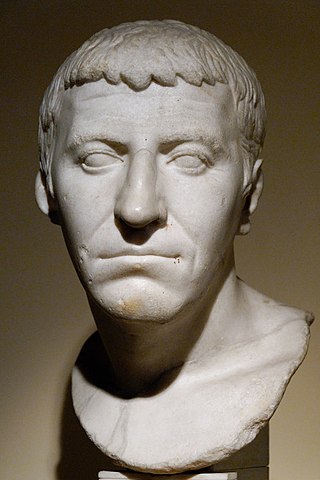
Gnaeus Domitius Corbulo was a popular Roman general, brother-in-law of the emperor Caligula and father-in-law of Domitian. The emperor Nero, highly fearful of Corbulo's reputation, ordered him to commit suicide, which the general carried out faithfully, exclaiming "Axios", meaning "I am worthy", and fell on his own sword.

The Third Servile War, also called the Gladiator War and the War of Spartacus by Plutarch, was the last in a series of slave rebellions against the Roman Republic known as the Servile Wars. This third rebellion was the only one that directly threatened the Roman heartland of Italy. It was particularly alarming to Rome because its military seemed powerless to suppress it.

A pickaxe, pick-axe, or pick is a generally T-shaped hand tool used for prying. Its head is typically metal, attached perpendicularly to a longer handle, traditionally made of wood, occasionally metal, and increasingly fiberglass.

The Maedi were a Thracian tribe in antiquity. Their land was called Maedica (Μαιδική). In historic times, they occupied the area between Paionia and Thrace, on the southwestern fringes of Thrace, along the middle course of the Strymon, between the Kresna Gorge and the Rupel Pass. Strabo says that the Maedi bordered eastward on the Thunatae of Dardania, and that the Axius flowed through their territory.
Crixus was a Gallic gladiator and military leader in the Third Servile War between the Roman Republic and rebel slaves. Born in Gaul, he was enslaved by the Romans under unknown circumstances and trained as a gladiator in Capua. His name means "one with curly hair" in Gaulish.
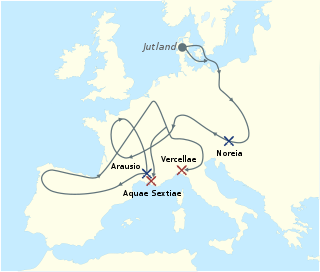
The Ambrones were an ancient tribe mentioned by Roman authors. They are believed by some to have been a Germanic tribe from Jutland; the Romans were not clear about their exact origin.

The sarcina was the marching pack carried by Roman legionaries, the heavy infantry of the Roman legions.

An entrenching tool (UK), intrenching tool (US), E-tool, or trenching tool is a digging tool used by military forces for a variety of military purposes. Survivalists, campers, hikers, and other outdoors groups have found it to be indispensable in field use. Modern entrenching tools are usually collapsible and made using steel, aluminum, or other light metals.
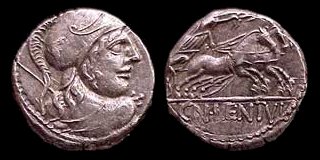
Gnaeus Cornelius Lentulus Clodianus was a Roman politician and general who was one of two Consuls of the Republic in 72 BC along with Lucius Gellius. Closely linked to the family of Pompey, he is noted for being one of the consular generals who led Roman legions against the slave armies of Spartacus in the Third Servile War.
Publius Varinius was a Roman praetor in 73 BC, proconsul in 72 BC, and a military commander who was unsuccessful during the Third Servile War.
Gaius Claudius Glaber was a military commander of the late Roman Republic, holding the office of praetor in 73 BC. During his term he was defeated in the Battle of Mount Vesuvius against the forces of Spartacus during the Third Servile War.
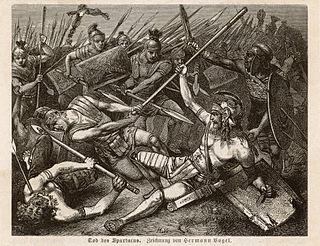
Spartacus was a Thracian gladiator (Thraex) who was one of the escaped slave leaders in the Third Servile War, a major slave uprising against the Roman Republic.

Desilo is an underwater archaeological site in southern Bosnia and Herzegovina, located near the Neretva river and the Croatian border. The site was first discovered in the late 20th century, but Desilo's history can be traced as far back as ancient times. Investigations by a University of Mostar archaeological team in 2007 uncovered many sunken boats at the bottom of the small lake in Desilo valley. The archaeologists believe these boats to be Illyrian ships, dating back to the first and second centuries B.C. Further excavations in 2008 by University of Oslo archaeologists found evidence suggesting that Desilo was an Illyrian trading post. These archaeological findings are significant because they are the first known discovery of Illyrian ships. Additionally, Desilo functioning as a trading centre suggests there were peaceful interactions between the Illyrians and the Romans.
Barry S. Strauss is an American historian. He is a professor of history and humanistic studies at Cornell University, and a visiting Corliss Page Dean Fellow at the Hoover Institution.
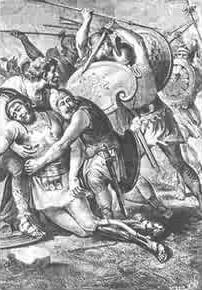
The Battle of the Silarius River was the final, decisive action of the Roman Servile Wars. It occurred near the mouth of modern Sele River, southern Campania, southern Italy.
Gannicus was a Celtic slave, who together with the Thracian Spartacus, Crixus, Castus and Oenomaus, became one of the leaders of rebel slaves during the Third Servile War. In the winter of 71 BC, Gannicus, along with Castus, broke off from Spartacus, taking a large number of Celts and Germans with them, marking the second detachment of the rebellion. Gannicus and Castus met their end at the Battle of Cantenna in Lucania near Mount Soprano, where Marcus Licinius Crassus, Lucius Pomptinus and Quintus Marcius Rufus entrenched their forces in battle and defeated them.
Castus was an enslaved Gallic man who, together with the Thracian Spartacus, the fellow Gaul Crixus, and Celt Gannicus, alongside Oenomaus, was one of the leaders of rebellious slaves during the Third Servile War. He was killed along with his co-commander Gannicus and their Gallic and Germanic followers by Roman forces under Marcus Licinius Crassus at the Battle of Cantenna in Lucania in 71 BC.

Julius Caesar's planned invasion of the Parthian Empire was a planned war of the Roman Republic against the Parthian Empire. The assassination of Julius Caesar in 44 BC prevented the invasion from taking place.













